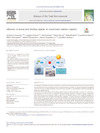Identificador persistente para citar o vincular este elemento:
https://accedacris.ulpgc.es/jspui/handle/10553/114216
| Título: | Influence of strong iron-binding ligands on cloud water oxidant capacity | Autores/as: | González González, Aridane Bianco, Angelica Boutorh, Julia Cheize, Marie Mailhot, Gilles Delort, Anne-Marie Planquette, Hélène Chaumerliac, Nadine Deguillaume, Laurent Sarthou, Geraldine |
Clasificación UNESCO: | 251010 Procesos litorales o sublitorales | Palabras clave: | Cloud oxidant capacity Iron complexation Cloud chemistry modelling Cloud microbiota |
Fecha de publicación: | 2022 | Proyectos: | BIOCAP ANR-13-BS06-0004 | Publicación seriada: | Science of the Total Environment | Resumen: | Iron (Fe) plays a dual role in atmospheric chemistry: it is involved in chemical and photochemical reactivity and serves as a micronutrient for microorganisms that have recently been shown to produce strong organic ligands. These ligands control the reactivity, mobility, solubility and speciation of Fe, which have a potential impact on Fe bioavailability and cloud water oxidant capacity. In this work, the concentrations of Fe-binding ligands and the conditional stability constants were experimentally measured for the first time by Competitive Ligand Exchange-Adsorptive Cathodic Stripping Voltammetry (CLE-ACSV) technique in cloud water samples collected at puy de Dôme (France). The conditional stability constants, which indicate the strength of the Fe-ligand complexes, are higher than those considered until now in cloud chemistry (mainly Fe-oxalate). To understand the effect of Fe complexation on cloud water reactivity, we used the CLEPS cloud chemistry model. According to the model results, we found that Fe complexation impacts the hydroxyl radical formation rate: contrary to our expectations, Fe complexation by natural organic ligands led to an increase in hydroxyl radical production. These findings have important impacts on cloud chemistry and the global iron cycle. | URI: | https://accedacris.ulpgc.es/handle/10553/114216 | ISSN: | 0048-9697 | DOI: | 10.1016/j.scitotenv.2022.154642 | Fuente: | Science of the Total Environment [ISSN 0048-9697], v. 829, (Julio 2022) |
| Colección: | Artículos |
Citas de WEB OF SCIENCETM
Citations
5
actualizado el 08-jun-2025
Visitas
76
actualizado el 16-mar-2024
Descargas
30
actualizado el 16-mar-2024
Google ScholarTM
Verifica
Altmetric
Comparte
Exporta metadatos
Los elementos en ULPGC accedaCRIS están protegidos por derechos de autor con todos los derechos reservados, a menos que se indique lo contrario.
